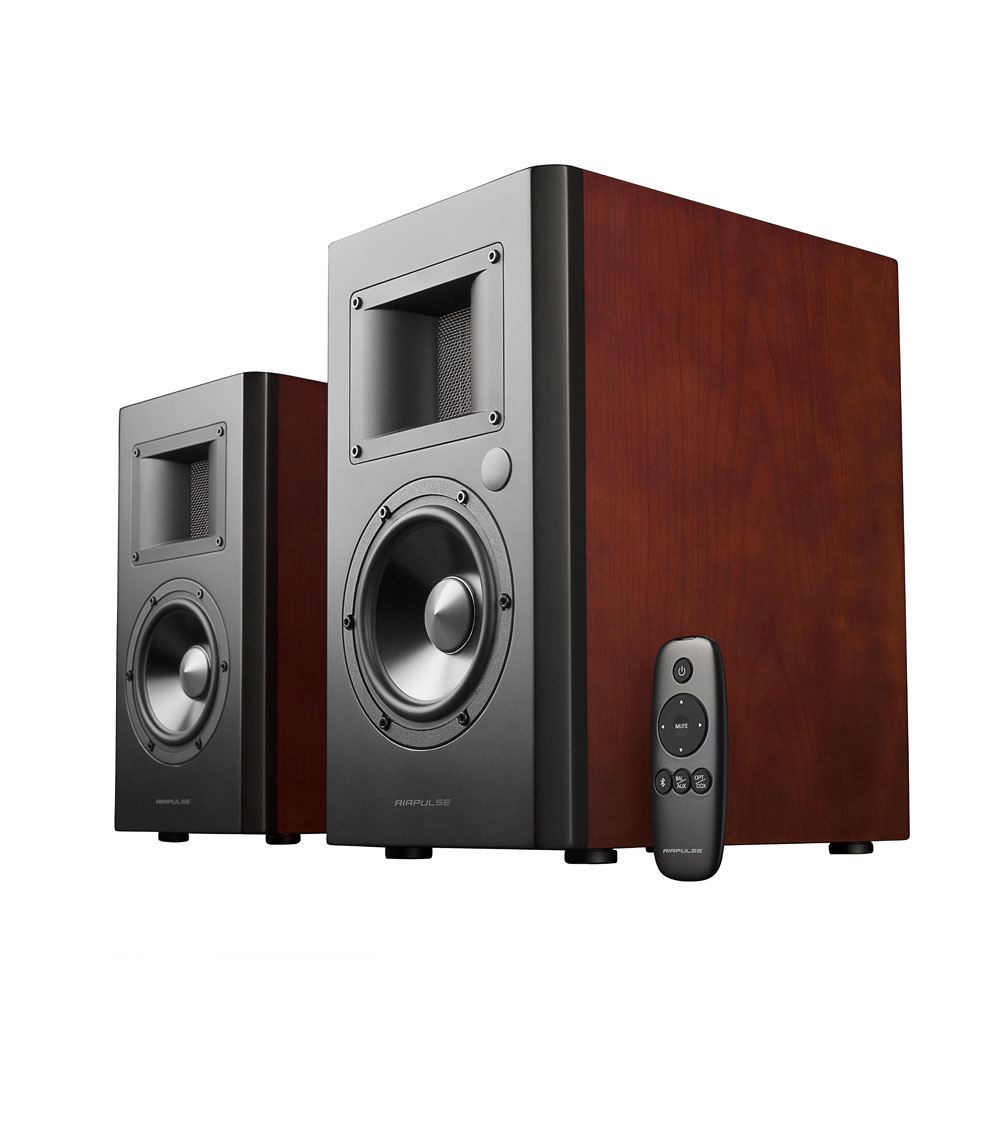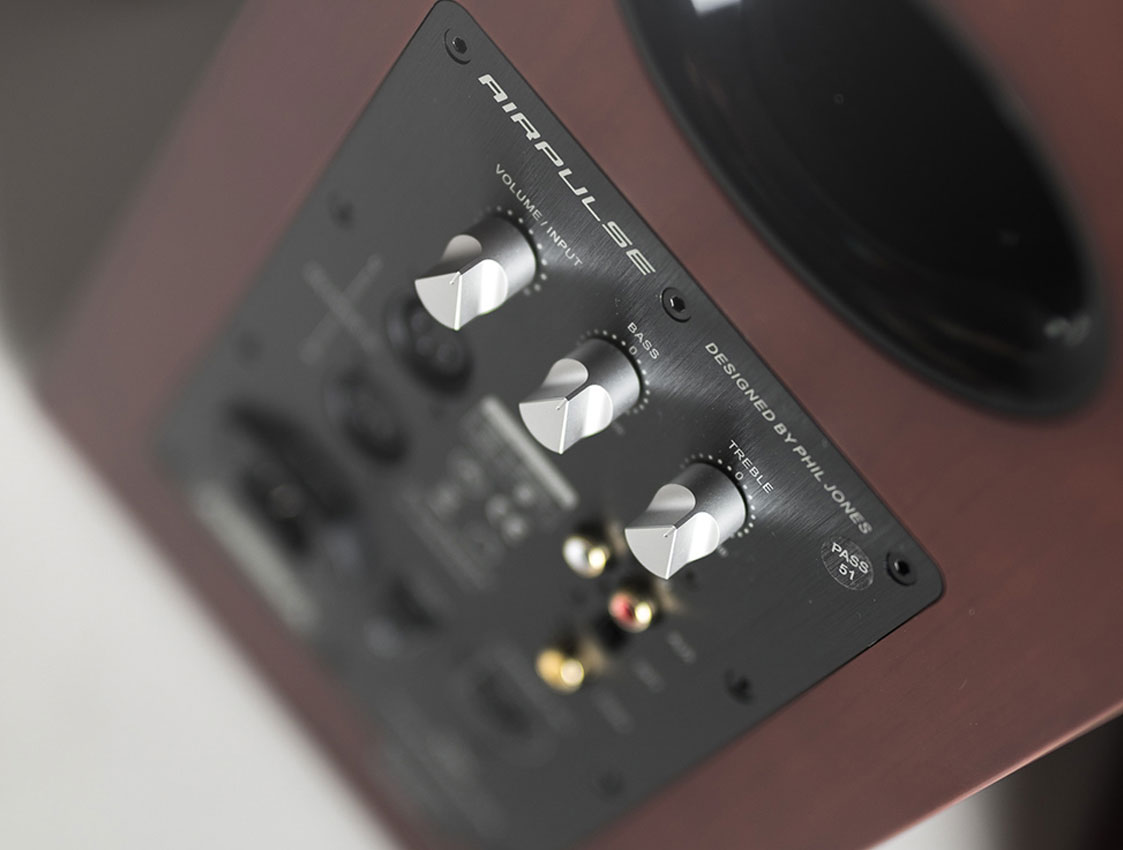There’s a lot of competition in the mid-priced active speaker market, with active designs increasingly favoured for simplicity, convenience and space-saving over a traditional setup encompassing a pair of speakers and a stack of boxes to drive them. That’s not to say that active speakers are always a compromise; quite the opposite in fact. In an active design, driving electronics can be optimised for a specific set of drivers. Many of the designs on the market are bi-amplified and crossovers are more often than not set electronically within a DSP, which can also provide for EQ to ‘shape’ the sound of the speaker. The AirPulse A300s are a mid-priced (approx. £899) offering packing some quality tech into a pair of sizeable standmount enclosures.
Those enclosures are internally braced for greater rigidity and driver support and are made from 25 mm MDF with a satin lacquered cherry wood veneer. The cabinets are lined with 36 mm damping material to further minimise colouration, and the cabinets are rear ported, so work best with some distance between the speaker and a rear wall and seated on stands with the tweeter roughly at ear height; matching ST300 stands are also available.
The driver array comprises a 6.5” mid bass driver with a hard anodised aluminium alloy cone suspended in a heavy duty, ultra rigid cast magnesium alloy frame and a 50mm edge-wound copper clad voice coil in an underhung design for higher sensitivity. The 65mm horn loaded ribbon tweeter offers superb transient response and an extended frequency response (up to 40kHz). A carefully calculated horn shape directs and optimises high frequencies and minimises the impact of room reflections.
In terms of the electronics, the A300s contain class D amplification courtesy of three Texas Instruments TAS5754; one each in bridge mode for the mid/bass drivers and a third to drive the tweeters. The TAS5754 offers support for 192kHz input sample rates and a high PWM carrier frequency of 768kHz, twice that of a traditional class D amplifier. Analogue inputs are digitally sampled to 96kHz with relay switching to avoid crosstalk. The Texas Instruments PCM9211 SPDIF receiver supports sampling rates of up to 216kHz with extremely low jitter. An XMOS XU216 16-core chipset handles digital processing and the USB interface, supporting USB audio class 2 mode with supported sampling rates of up to 192kHz. Finally, a Qualcomm Bluetooth chipset supports AptX for optimal sound quality from supported Bluetooth devices, though there is no support for AptX HD for high res streaming over Bluetooth.
Output power is 10W+10W (treble) and 70W+70W (mid bass), with the frequency response quoted as 40Hz-40KHz and SNR ≥90dB(A). I was not able to obtain a linearity measurement for the frequency response though my listening tests would indicate that it is not entirely flat, tuned perhaps with a slight lower mid bump to increase the perception of ‘musicality’ and a small bass bump to improve dynamics.
In the box are provided a range of cables including optical, USB (A-B) RCA to RCA and RCA to 3.5 mm, as well as a 5 metre 5-pin DIN cable to connect the two speakers. A remote control is also provided, with a slim profile that does feel somewhat light in the hand but offers nice tactile controls for power, volume, input selection and basic transport controls for connected Bluetooth and USB devices. The remote takes a pair of AAA batteries which are also included.
Bass and treble controls are to be found on the right-hand speaker via nicely machined triangular metal dials, though placed somewhat inconveniently on the back. Jointing them is a rotary control for volume with a press action to switch inputs and bring the speakers in and out of standby. Input wise there are both RCA and balanced XLR inputs, optimal and coaxial, USB B and an IEC input for power with a hard power switch.
Sound wise the A300s are crisp, clean and powerful. Though revealing thanks to that ribbon tweeter they aren’t at all fatiguing, with oodles of detail at the top end and seamless integration between the two drivers. Though they can produce tremendous quantities of low end – and scale to rival a small floorstander – the low end is refined and not at all overbearing. Mids are full and forward, yet cohesive with the rest of the spectrum. These are not tuned to be entirely flat; rather they have a musical tonal character that could perhaps be said to be somewhat ‘warm’, though with a considerable amount of punch and power. They’re capable of playing loud too, though with no sign of struggle even at high levels.
The A300s are a mid-priced active speaker packing powerful class D amplification, quality components and plenty of features into a pair of solid and well finished enclosures. Their price and size places them in a segment of the market where there is a great deal of competition, but they compare very favourably to models far beyond their price. Highly recommended.







